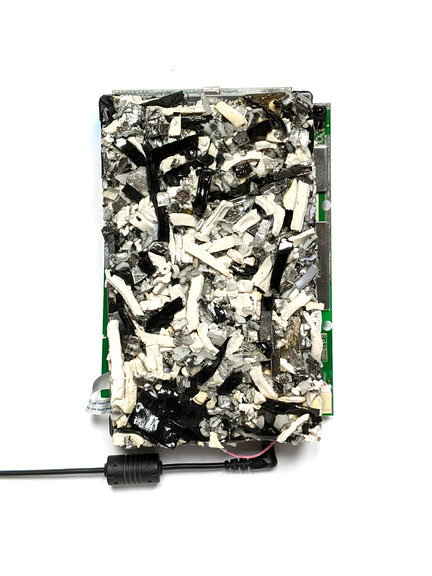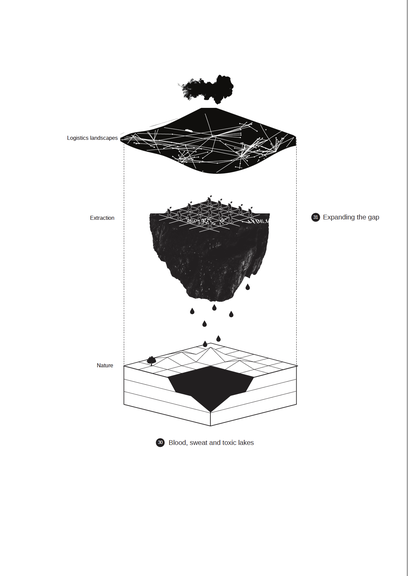Issue 3/2021 - Digital Ecology
Can Art Do the Work?
From Narratives to Protocols, from Habit to Ethics
“The work needs to do the work” James Bridle emphasizes in a short online talk of his, discussing the role of art in the era of the climate crisis.1 “To make artworks about ecology is not representative anymore. It is not only about telling stories. It is certainly not only about conveying facts. We already know everything we need to know; rather, we need to do the work.” Bridle, interestingly, is also speaking with reference to his own practice, as an artist who until recently was working on and with technology and now is more interested in the use of renewable energy and in agricultural systems. His statement can be understood within the context of an art that is merged with activism, community and collaborative work, and, of course, also ecology. It points to an art that takes a stance, having a social and political character, and to practices that are useful because they provide tools and communicate knowledge. Different associations can be made, as Bridle stresses that we need actual actions that can create new narratives.
What is wrong with existing art-driven narratives and representations, though, and what are those much-needed actions? How has the relationship of technology to ecology been understood thus far? What has the role of art been in understanding, forming, or even changing this relationship, and how can it be re-imagined?
The climate crisis we are experiencing nowadays is to a great extent communicated through various forms of narrative. The story of anthropogenic activity on the planet is told through scientific facts, and through the processing and visualization of climate data. Scientific facts, weather events, and climate predictions form the starting point for the narratives formed by social climate movements in their attempt to fight climate change and claim climate justice. This same ground is also covered by art and culture, which, through projects, exhibitions, and events, use narratives to address the current planetary emergency.
Digital technologies play a significant role in a number of ways in the formation of the aforementioned narratives. First, together with sensing technologies and machine learning, they allow us to capture information found in the air, the soil, and the water, as well as to process big climate data in order to discuss change on a planetary scale. Second, thanks to global communication, media information about the climate is openly and widely shared. Third, digital technologies together with environmental sciences offer the basis for developing proposals regarding the possible optimization and restoration of earth’s climate and ecosystems. Ambiguous scenarios such as geoengineering manifest how intervention on a planetary scale is approached by some as desirable and feasible. At the core of this attitude, however, is the problematic belief that the planet is an object that can be endlessly used, programmed, and even re-made, like “a pilotable machine,” as Frédéric Neyrat puts it.2
The world of technology not only assists humanity in studying, comprehending, and facing the climate crisis. As often discussed, it also itself accelerates environmental deterioration. This is exemplified by the mining for minerals used to manufacture electronic devices and physical computers, the consumption of fossil fuel power needed for their production and operation, and the toxicity of the e-waste produced. The role of technology in the era of the climate crisis is therefore undoubtedly ambivalent and paradoxical, as technological systems seem to be proposing answers to problems that have been created to a great extent by their own abuse.3 The compound and controversial character of technology has been discussed and emphasized in artistic projects that take their cue from the work of scholars in the field.
In her most recent book, Atlas of AI, Kate Crawford emphasizes the intensive computational processes that data mining and machine learning involve. “The term ‘artificial intelligence’ may invoke ideas of algorithms, data and cloud architectures, but none of that can function without the minerals and resources that build computing’s core components.”4 This statement also applies to the climate data being processed. New forms of extractivism meet old ones as data and traditional mining operate side by side. Any problem with data can only be solved with more data. This dilemma was presented in the map Anatomy of an AI System (2019)5 created by Vladan Joler in collaboration with Crawford, as well as in Joler’s most recent work, New Extractivism: An assemblage of concepts and allegories (2020).6 The recent map brings together ideas, things, and people that manifest the different levels and forms of extractivism and exploitation, from human to earth labor. But the involvement of AI in the depletion of natural resources does not end there. Artist Frederick De Wilde examines in his recent three-channel installation Hyperminer_Extracted Earth (2021)7 how mining operations work faster and more accurately and efficiently thanks to machine learning. AI infrastructures are today increasingly used for the allocation and monitoring of resources as well as for the actual drilling. Better predictions mean better planning and better return on investment,8 but how does this decrease the AI footprint and the reckless depletion of the planet’s wealth? De Wilde studies how the earth is being scanned just like an object, raising questions about the interests and values that are prioritized.
Other artists have focused especially on the energy consumption of technological systems and of connectivity itself, from the manufacturing to the powering of infrastructures of different scales. Back in 2014, Timo Arnall shot the film Internet Machine, which revealed the materiality of the cloud, arguing how important it is to “be able to see and hear the energy that goes into powering these machines and the associated systems for securing, cooling and maintaining them."9 His film captured how massive the data center infrastructures are and how they are kept cool. A few years later, the big tech companies communicated their increasing use of renewable energy, with artificial intelligence facilitating the process. It is true that nowadays AI systems provide significant assistance in reducing energy use and predicting temperature and pressure, as well as making recommendations regarding consumption. For these reasons, technology giants are often discussed as role models for the energy transition to renewable energy. But some sides of the story are hardly mentioned. When, for instance, water is used instead of electricity, it is important to consider what kind of water is needed and at what cost. Or even more, what happens when clean water is prioritized for communication rather than for people? This is a question that Mel Hogan raises, while pointing out that this is how big data ecologies are born; their “greening” entails “thin narratives that deploy textual and visual rhetorical strategies intended to obfuscate and overwrite resource exploitation.”10 At some point, the planet’s ecosystem can no longer be replenished; it is not endlessly renewable.
It is thanks to the earth and its geological strata that technical media operate, but this is also where disposable digital culture ends up. As Jussi Parikka and Garnet Hertz have noted, “media never die but remain as toxic waste residue.”11 The remains of technological devices end up in the earth’s body after their use, and become part of the future geological history. They constitute a “natural history of electronics,” as Jennifer Gabrys has put it,12 and they contribute to the exercise of “slow violence”—a term coined by Rob Nixon—over poorer areas and populations that pay the price of today’s technological way of living.13 Benjamin Gaulon, an artist who has consequently worked on the topic of electronic waste, emphasizes that at some point it is only the “brutal materiality” of devices that is left. In his works Ultimate Waste, Internet Compression, and L’Essence Même (2020),14 Gaulon has transformed devices by shredding them. A thin plastic item is presented that is still capable of leaking pollutants into the ground, air, and water. Plastic, as Heather Davis points out, has an “unruly relationship to time.” Plastic, in her words, constitutes a form of inheritance and a medium that connects the deep past to the deep future, “extending precarity and toxicity.”15 E-waste, accordingly, is an unfortunate legacy for the generations of the present and the future, especially the ones from areas that have been the least responsible for its accumulation.
Looking into the problematics of extractivism, energy consumption, and e-waste, artists have been discussing the controversies of the promises of technological systems and especially of artificial intelligence in relation to the environmental crisis. They have been producing narratives that inform us about and shed light on the dark sides of digital culture. At the same time, though, in the last few years various initiatives have emerged that try to address these topics from different perspectives and in relation to different worldviews, underlining the role of habits and ethics.
In order to rethink the relationship of technology to the environment, one would need to re-imagine the relationship of the human to the machine, and more specifically to Artificial Intelligence. The Indigenous Protocol and Artificial Intelligence Working Group works in this direction, studying in particular how Indigenous epistemologies can accommodate the non-human and establish new kin networks “respectfully and reciprocally.”16 Within this context, the problem of extractivism is discussed by paying attention to relationality, which is at the core of Indigenous thought. According to the group, a relationship to AI directly involves a relationship to the materials of the earth, to mines and stones, to resources. These are fundamental bonds that cannot be doubted or questioned and that need to be carefully protected through thoughtful protocols. Researcher and artist Suzanne Kite specifically explains that AI can be a force for the good when values are shared and embraced by a community, instead of being decided for the many by governments and corporations. Protocols, according to the Indigenous AI Group, need to take under consideration both the relationships with other humans as well as the relationships with “non-humans, such as animals, rock, and wind.”17 Such protocols would compel developers to acknowledge and attend to these bonds when building technologies and tools.
This is the direction that artists and designers Tega Brain, Alex Nathanson, and Benedetta Piantella are heading in as they develop the project Solar Protocol (2020).18 Solar Protocol is a web platform hosted across a network of solar-powered servers set up in different locations around the world. The server that is used at a given time is the one located where the most sunshine is, and this means that each server can offer connectivity for a specific duration of time depending on weather conditions. With its title and concept, the project aims to honor “the natural logic,” exploring the relationship of the earth to the sun “as a form of intelligence that is used to automate decisions in a digital network.” The path from client to server is determined according to the sunshine, and this at the same time is an invitation for its users to change or adapt their habits. Just as our routines depend on the hour of the day and the weather, we can also change our online activity accordingly. Instead of taking 24/7 connectivity as a given, we need to learn to be patient and opt for lower quality of appearance and intervals. Solar Protocol prioritizes saving energy rather than producing the quickest results. Assuming that the energy sources are renewable, we cannot always be online. Solar Protocol is based on the prior and ongoing research project undertaken by Kris de Decker and Roel Ascam Abbing, who initiated Low-Tech Magazine19 and, as part of it, started examining what a solar-powered website could mean: being static, having two-color images but also making it possible for users with older systems to view it. Through their work, they underline the need to understand the connection between data and energy, to leave one’s comfort zone and turn towards viable solutions that are easy to implement and maintain.
Low-tech forms of the past are merged with traditional knowledge and artistic methodologies at an art, science, and agriculture space called Sakiya near Ramallah in Palestine.20 Initiated by artist Nida Sinnokrot and architect/conservationist Sahar Qawasmi, the space approaches agriculture as a lively part of culture, of the past and present, and places the principles of permaculture at the core of its practice. Their events for instance follow the logic of the “guild,” with groupings of plants, trees, animals, and insects that work together and enhance each other. Artists, agroecologists, teachers, builders, and technologists collaborate here, sharing their experiences and knowledge. Similarly, the logic of rewilding refers to “the rewilding of the soil from the ravages of monoculture agriculture” as well as to “the rewilding of local knowledge cultures from encroaching neoliberalism.” Embracing the principles of permaculture and applying them to the arts and to culture means using time differently, making decisions differently, and prioritizing community over individual goals. John Jordan from the Laboratory of Insurrectionary Imagination highlights the principle of observation and how art can help in paying closer attention to the changes in the surrounding world.21 Permaculture offers a holistic perspective for thinking and comprehending how human and more-than-human habitats are affected in the long term.
Technology is not neutral, nor does it happen in a vacuum, as Rosemary Lee highlights. Contextual factors are of great relevance in the formation of different media ecosystems22 and "media natures"23 that constantly affect and shape our living environment. Does art then in the end do the work better when it acts, rather than when it tells real stories depicting a planet in a state of emergency? Is art meant to take action instead of stimulating our thoughts and senses? Such questions are open-ended and recurring, increasingly coming to the fore in times of planetary crisis. The diverse examples mentioned above all share the same starting point: that the separation of technology from ecology, of the human from the more-than-human world, needs to be overcome. The alternatives offered cannot constitute an excuse for continuing to exhaust the earth’s natural resources. Similarly, the technological solutions proposed cannot force societies of consumption to change their habits. Art that "does the work," just like art that tells a story, might still have a limited impact, operating to an extent on a symbolic level. But sometimes there is a logic of “doing [things] speculatively,”24 of offering a space to imagine the much-needed transformations. What the different practices and methodologies mentioned do accomplish in any case is to advocate for distancing from sovereign technological models and for paying attention to questions of context and scale. Art is therefore in the foreground when it comes to speaking for the radical changes and the work needed individually but also collectively if we are to shift perspectives, change our habits, and consider ethics while thinking across generations, geographies, and cultures.
[1] James Bridle, contribution to the panel “Art-Driven Narratives to Combat the Environmental Crisis | Climate Culture” organized by the Onassis Foundation, https://www.youtube.com/watch?v=f80weIOoXGg&t=2126s.
[2] Frédéric Neyrat, The Unconstructable Earth: An Ecology of Separation, trans. Drew S. Burk (New York: Fordham University Press, 2018), 1–3.
[3] Daphne Dragona, “Reprogramming Earth,”NeMe, https://www.neme.org/projects/reprogramming-earth.
[4] Kate Crawford, Atlas of AI (New Haven & London: Yale University Press, 2021), 30.
[5] Kate Crawford and Vladan Joler, Anatomy of an AI System, https://anatomyof.ai/.
[6] Vladan Joler, New Extractivism: An assemblage of concepts and allegories, https://extractivism.online/.
[7] Frederik De Wilde, Hyperminer_Extracted Earth, https://frederik-de-wilde.com/project/hyperminer-extracted-earth/.
[8] Ron Schmeltzer and Cognitive World, “AI Helping Extract Value In The Mining Industry,” Forbes, https://www.forbes.com/sites/cognitiveworld/2019/08/09/ai-helping-extract-value-in-the-mining-industry/?sh=5083d9697006.
[9] Timo Arnall, Internet Machine, https://www.elasticspace.com/2014/05/internet-machine.
[10] Mél Hogan, “Big data ecologies,” Ephemera, 18, no. 3 (2018), 631–657.
[11] Jussi Parikka, A Geology of Media (Minneapolis, MN: University of Minnesota, 2015), 141.
[12] Jennifer Gabrys, Digital Rubbish: A Natural History of Electronics (Ann Arbor, MI: University of Michigan Press, 2011).
[13] Rob Nixon, Slow Violence and the Environmentalism of the Poor (Cambridge, MA: Harvard University Press, 2011).
[14] Benjamin Gaulon, Ultimate Waste, Internet Compression and L’Essence Même, http://www.recyclism.com/techmining.html.
[15 Heather Davis, Plastic Matter (Durham. NC: Duke University Press, 2022).
[16] Jason E. Lewis, Noelani Arista, Archer Pechawis, and Suzanne Kite, “Making kin with the machines,” Journal of Design and Science (2018), https://jods.mitpress.mit.edu/pub/lewis-arista-pechawis-kite/release/1.
[17] Jason Edward Lewis, Angie Abdilla, Noelani Arista, Kaipulaumakaniolono Baker, Scott Benesiinaabandan, Michelle Brown, Melanie Cheung et al., “Indigenous protocol and artificial intelligence position paper,” 2020, 7, https://spectrum.library.concordia.ca/986506/7/Indigenous_Protocol_and_AI_2020.pdf.
[18] Tega Brain, Alex Nathanson, and Benedetta Piantella, Solar Protocol, http://solarprotocol.net/.
[19] https://solar.lowtechmagazine.com/.
[20] https://sakiya.org/.
[21] Lars Kwakkenbos, “Art, Activism and Permaculture,” Interview with Isa Fremeaux and John Jordan, https://fpif.org/art_activism_and_permaculture/.
[22] Rosemary Lee, “Resilience as a critical approach to technology,” Feral Labs Node Book #1: Rewilding Culture, https://www.makery.info/en/2021/06/17/english-rosemary-lee-resilience-as-a-critical-approach-to-technology/.
[23] Parikka, 6ff.
[24] Sophie Toupin and Spideralex, “Introduction: Radical Feminist Storytelling and Speculative Fiction: Creating new worlds by re-imagining hacking,” Ada: A Journal of Gender New Media & Technology (2018), https://adanewmedia.org/2018/05/issue13-toupin-spideralex/.


